
The inspiration for this little wall quilt comes from a magnificent American quilt now in the St.Peter Port museum on Guernsey, in the Channel Islands. The original quilt is an outstanding example of a style described as 'Classic Floral' by Ricky Clark in her book Quilted Gardens.(Rutledge Hill Press, 1994). Exactly how this quilt came to be in Guernsey is not clear, but it was almost certainly made by a member of the Ogier family, who emigrated to Guernsey in the Eighteenth Century and were among the founders of Guernsey County, Ohio.
The date 1842 and the initials PO are worked into the front of the quilt in trapunto lettering. Surviving correspondence between emigrees and members of the family who emained in Guernsey show that they remained in touch and it is thought that the quilt was probably sent over as a wedding gift.
The date 1842 and the initials PO are worked into the front of the quilt in trapunto lettering. Surviving correspondence between emigrees and members of the family who emained in Guernsey show that they remained in touch and it is thought that the quilt was probably sent over as a wedding gift.
When the original quilt was brought to my attention, I nick-named it The Guernsey Lily as there is a real flower of that name. (For any botanically-minded readers:Nerine sarniensis, or the Guernsey lily, was named when a ship was wrecked many years ago on Guernsey, the second largest of the Channel Islands, located off the coast of Normandy. Nerine bulbs washed ashore and took root on the island's sandy beaches. Because the ship was Japanese, it was originally believed that they were Japanese in origin, hence another of the common names, Japanese spider lily, but they are actually native only to South Africa.)
In her book, Clark refers to, and illustrates, a similar quilt,as 'Tulip';its provenance points to the probability that it was made by Mary Ogier of Vinton County, Ohio, which suggests that she may also have made the Guernsey version.
The block, of course, is simply one of innumerable variations on the ubiquitous pieced floral block most familiar as'North Carolina Lily', although it seems to have a different alias in every American State where it appears.
In her book, Clark refers to, and illustrates, a similar quilt,as 'Tulip';its provenance points to the probability that it was made by Mary Ogier of Vinton County, Ohio, which suggests that she may also have made the Guernsey version.
The block, of course, is simply one of innumerable variations on the ubiquitous pieced floral block most familiar as'North Carolina Lily', although it seems to have a different alias in every American State where it appears.

No comments:
Post a Comment